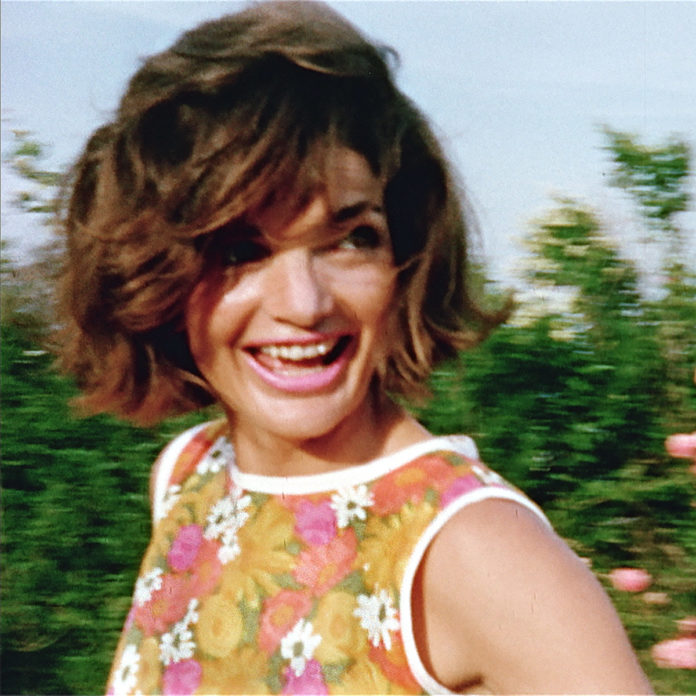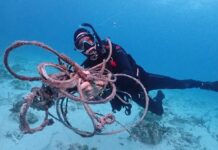The second floor of the Cooper Hewitt, Smithsonian Design Museum is dark, quiet and cool, even on a sweltering summer day in Manhattan. The building, once the gilded age mansion of Andrew Carnegie, is full of high ceilings, hardwood staircases, ionic pillars, and other architectural flourishes, all of which can be a little stultifying to the modern eye.
What wakes the place up is the stuff on the walls, brought into focus by sharp museum lighting – the whelks and rhinos and puffins, the innumerable varieties of flowers, the riots of color in glass frames. The paintings and prints were all the creations of Suzie Zuzek, known to most Key Westers as Suzie de Poo. (Zuzek was her maiden name and how she signed her art.) It was all work she created during her 25 years as the lead designer for Key West Hand Print Fabrics. It was all work that, with little credit to the creator, helped Lilly Pulitzer become one of the most iconic American clothing labels of the 1960s and ‘70s.
It is rare for a regional artist to have a major show in such an august institution, rarer still for a fabric designer, especially one who, until now, did not have much name recognition outside of Key West.
The evolution of the exhibit “Suzie Zuzek For Lilly Pulitzer: The Prints That Made The Fashion Brand” — on display until Jan. 2, 2022 – is a story that might never have been widely told if not for one woman’s threadbare boudoir chair. But first, a few words about the artist herself.
From New York to Key West
Zuzek was not initially keen on the idea of living in Key West.
She’d grown up on a dairy farm in upstate New York, served as a WAC (Women’s Army Corps) during World War II, and enrolled at the Pratt Institute on the GI Bill, where she specialized in commercial art and textile design and graduated at the top of her class.
She was freelancing as a fabric designer when she met Key West native John de Poo through her roommate Jeannie Porter Kirke. He’d been a merchant mariner but stopped going to sea once they were married, and had been unable to find anything but menial work in New York. They had two daughters and another on the way.
“The family story is that my father would be packing the car to leave for Key West and she’d be unpacking the car. She wasn’t happy to move down here in the beginning,” said her oldest daughter, Kathryn de Poo. That was in 1955.
Once she was finally on the island, though, her attitude began to shift.
“All this was new and tropical, and she’d never been exposed to it. So she was inspired by it,” said her youngest daughter, Martha de Poo.
At first they lived in a small house on Johnson Street. Zuzek got involved in the local arts community, painting backdrops for the Waterfront Playhouse, hanging art shows for the Key West Art Center, making pen and ink drawings of shrimp boats to sell to tourists.
When the family moved to a larger place on Dey Street, she began to collect animals, with a menagerie that at various times included a red-and-green macaw, an alligator, raccoons, a horny toad, a donkey, peacocks given to her by Janet Reno’s parents, and a squirrel monkey that had a tendency to escape and explore the homes of other families. She also took care of fellow artist Henry Faulkner’s goats when he was out of town. There may also, at some point, have been a bobcat.
Zuzek’s work grew more eclectic. She worked with found and recycled materials long before anyone in the art world described them as such, painting on tiles, pieces of driftwood, chunks of abandoned plywood, and other oddities that presented themselves, wiring together sculptures from old roofing tiles and other detritus. She drew inspiration from the local flora and fauna.
“She loved all natural things, all nature,” Martha said.
For a while she dug up antique bottles down on Rest Beach. When that became too competitive (you could sell them to tourists) she began to collect the chunks of broken glass that no one else wanted, filling about 20 metal shrimp baskets with them, which had to be secured every time there was a hurricane, but which she would later incorporate into her signature mobiles and sculptures.
“She was the original shabby chic,” said Kathryn. “We never had real curtains in our house. There was a time we even had, like, fishnet that was stapled up. Then she’d just buy lengths of cloth and staple them up. And that would last for a year. And then she’d rip them down and staple up something else.”
“Her major uniform was men’s shirts that she’d buy at yard sales or at Salvation Army. She cut off the cuffs. Sometimes she’d sew the cuffs on a skirt or on the bottom of the shirt as a pocket,” said Kathryn.





She once came home laughing because a tourist had thought she was a bag lady and gave her $5. (She kept it.)
She would, on occasion, take a long skirt and hike it up to her armpits and just wear that. Kathryn remembers being mortified when her mother arrived to pick her up at school that way, because sitting in the car she looked naked.
“It was somewhat embarrassing to have a mother that eccentric when you’re a young kid. You want to fit in. It wasn’t until we were in high school and our house was really a cool place to hang out that our mood changed,” said Kathryn.
Key West Handprint Fabrics was started in 1961 by three refugees from the New York theater world – Peter Pell and Jim Russell, who were a couple, and their friend Walter Starcke – as well as a local launderette owner named Bill Johnson. The plan was to sell brightly colored fabrics and tea towels to tourists. They hired a designer early on, but he only lasted about three months and left them in chaos. Pell stepped into the role with limited success. And then someone told the fledgling business owners about Zuzek, a local artist with experience in textile design.
Zuzek’s relationship with John de Poo had ended (they never filed for divorce), leaving her as a single mother with three daughters to feed. Though her art sold pretty well, she needed a day job. She started at Key West Handprint Fabrics at the same time Martha started school.
Zuzek’s designs were a revelation to everyone, bright, striking, impossible to ignore. You could find bermudagrass greens, cornflower blues, deep cerises, bashful pinks, persian reds, pale coppers, arylide yellows – all on one pattern. The fabrics were illustrated with drawings of angelfish, frigatebirds, hibiscuses, monocled cats, glowering suns, orchids, yin and yang penguins, minnows. There was a precision and a complexity to them belied by the seemingly casual lines of the art and their sense of unbridled spontaneity. Even the flowers were energetic.
Her patterns caught Lilly Pulltzer’s eye soon after Zuzek started at Key West Handprint Fabrics.
Pulitzer, who lived in Palm Beach, had started a line of simple shift dresses that had caught on like a house afire, but she’d been sourcing most of her fabrics from Woolworths and other five and dimes.
“Lilly Pulitzer was ultra wealthy and traveled in a very elite circle and that certainly didn’t hurt in terms of the success of her brand. It was marketed in that way – for people who could afford and had need of resort wear,” said Susan Brown, who curated the show at Cooper Hewitt and also wrote an essay in the accompanying coffee table book.
Jacqueline Kennedy, a school friend, was photographed multiple times wearing Lilly Pulitzer.
The shifts were also comfortable, de-emphasizing the waist, freeing women from bulky foundation garments like girdles and garter belts, and according to some fashion historians, paving the way for the miniskirt.
Pulitzer visited Key West Hand Print Fabrics in 1962, saw Zuzek’s designs, and ordered 300 yards on the spot. When she got back to Palm Beach she called and upped the order to 3,000 yards.
It was the start of a business partnership that would last 25 years, with Pulitzer ultimately owning a 51% share of Key West Hand Print Fabrics. By the mid-’60s they were producing up to 5,000 yards per week. In that time Zuzek was the creative engine of the whole operation, designing some 2,700 different patterns and over 85% of the fabrics used in the Lilly Pulitzer line between 1962 and 1985.
Zuzek was always a salaried employee. Both Martha and Kathryn say they often encouraged their mother to demand a percentage of the profits, and sometimes she would.
“They kept saying, you’re essential to this. You’re the family. We couldn’t do this without you, but they never formalized that. What they allowed her to do was work less hours. So she could continue to do her artwork at home in the mornings,” said Kathryn.
The Lilly Pulitzer company went bankrupt in 1985. Key West Hand Print Fabrics was sold off to a group of local businessmen, allowing Lilly Pulitzer to keep the trademarked name, which she sold off in the 1990s for the reconstituted version of the brand that is available today. Zuzek moved on. The design archive was shoved up into an attic and largely forgotten by everyone, another victim of the quicksands of corporate interest. Until Becky Smith arrived in 2007.
Smith, who describes herself as a former lawyer with four kids, had worn a lot of Lilly Pulitzer growing up. She’d even had a Lilly Pulitzer boudoir chair, an heirloom she wanted to have reupholstered to give to her daughter. She came to Key West on a quest to find the right fabric, maybe in a thrift store or someone’s closet. She found her way to Zuzek instead, who told her the story of her career. At first Smith was incredulous, but she did her research and found out everything Zuzek said was true.
She found herself fired up
“What if your mom sat on the second floor of an art studio for a quarter of a century and created all this, and nobody knew her name? Or the extent to which she created this look? It was like the trademark name was holding her legacy captive,“ said Smith.
It took several years, but eventually Smith organized a group of investors called the Original I.P. to purchase the acetates, original paintings, drawings, and other materials, as well as the copyrights to all the work for an undisclosed sum.
“Fortunately, because the archive had been tucked away for so many years, it wasn’t exposed to the air and to the sunlight and what have you,” Smith said. “We filled a semi-tractor trailer to within one inch of the back door, and brought it all up to St. Louis, and spent the last three to four years cataloging and conserving it to museum standards.”
Previous to the Cooper Hewitt show, Smith and company helped organize shows of Zuzek’s work at The Studios of Key West and the Key West Art and Historical Society.
Unfortunately Zuzek died in 2011 and did not get to witness the renewed appreciation of her legacy.
“She created an entire genre of textile design that was used in fashion in the United States in the 20th century. And it really touched the lives of millions of people. When you have that kind of an impact, and then nobody knows your name, because it was hidden under layers of bankrupt companies and egos and what have you. When you have an impact like that, it needs to be saved. So that’s what we did. That’s what we’ve done.”























